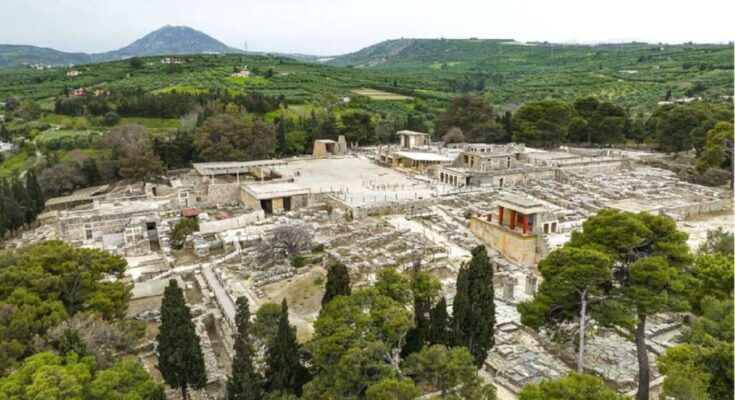
The people of ancient Greece have been known for many things, but have we ever thought about what their relationship with the environment looked like?
The ancient Greeks are known around the world for their remarkable contributions to many areas of everyday life and their groundbreaking works in philosophy, art, and architecture. However, their wisdom extended well beyond these much-analyzed areas.
To be precise, the Greeks had remarkably advanced environmental practices in the way they worked, lived, and interacted with the Earth, and these remain relevant to this day.
Many of their practices had their focus placed on issues such as conservation and sustainability. These practices can provide valuable lessons for modern society and the way we have structured our modern world. But what were some key environmental practices of the ancient Greeks that are relatively unknown, and what can we learn from them?

Respect for the environment in ancient Greece’s mythology and philosophy
The ancient Greeks followed a philosophical approach to nature and thus had a deep respect for the natural world.
This was evident in many aspects of their lives, and it was therefore reflected in their mythology and philosophy. Well-known Greek myths had the tendency to present natural phenomena as gods and goddesses in a clear attempt to personify them. This reveals the high esteem they had for the forces of nature.
An example of this might be Demeter, who was the goddess of agriculture, Poseidon, who ruled the seas, and Artemis, who was the protector of wild animals. By blending nature with clearly divine qualities, the Greeks show us that they believed nature had an inherent value and they therefore needed to live in harmony with it.
Well-established Greek philosophers needed to study the natural world as part of their educational journey. This is the reason why they understood and recognized the relationships of living things, animate and inanimate.
Aristotle, for example, became widely known not only for his philosophical ideas but also his significant contributions to the fields of biology and ecology. He observed and classified a large number of plant and animal species, and acknowledged that living organisms adapt to their environments.
This fundamental worldview encouraged his fellow Greeks to see themselves as part of a wider picture, the picture of nature, rather than separate from it.

Sustainable agriculture practices
The ancient Greeks were particularly good at keeping their agriculture as sustainable as possible. Over the course of time, they managed to develop a series of particularly sophisticated techniques.
Their main goal was to ensure that their production would be maintained in the long run, without depleting their resources. Agriculture was indeed the foundational element of the Greek economy for centuries, and this is why the Greeks understood how important it was to maintain healthy soil and maximize their yields without overusing natural resources.
One of the main things the Greeks were good at was crop rotation. The fact that they were using this technique shows us they understood that planting the same crop in a field year after year could lead to severe soil exhaustion. This was true because the plants would continuously draw out the same nutrients, eventually leaving the soil empty.
To prevent this from happening, they would rotate their crops. They would plant different species in a specific field each season. For instance, they might plant wheat one year, followed by legumes the next, and then allow the field to “rest” the third year. This allowed the soil to recover significantly and replenish its nutrients, thus ensuring its fertility for future seasons.
During the resting period, which is known as fallowing, the fields were left to grow wild plants. This would help them to restore organic matter and nutrients to the soil. The practice also helped the farmers break the much-hated pest and disease cycles, as the absence of host crops would disrupt the life cycles of harmful organisms.
The Greeks were also very good at using a technique called intercropping, which is essentially planting more than one crop together in the same field.
This would also be extended even further to practices such as planting crops with different times of growth and varying nutrient requirements together. An example of this would be planting fast-growing lettuce between slower-growing cabbages.

This particular technique helped them maximize the use of space along with their limited resources. Additionally, it reduced the impact of pests and diseases on their crops. This diversity of plants in an intercropped field also created a much more balanced ecosystem, attracting a wide range of very beneficial insects and reducing the need for pesticides.
In addition to these techniques, the Greeks paid close attention to soil health. They understood how important it was to maintain a balance of much-needed nutrients in the soil. This is the reason why they used various methods to achieve this. One such method was the planting of legumes, such as chickpeas, lentils, and broad beans.
These plants have the unique ability to fix nitrogen from the air and transfer it to the soil. In doing so, they enrich it with this largely essential nutrient. The Greeks would often plant legumes as a cover crop as well, which would be ploughed back into the soil as green manure.
Furthermore, they practiced another form of sustainable agriculture—agroforestry. By this, we mean the integration of trees and shrubs into their agricultural landscapes. They would actually plant a number of trees like olives, figs, and almonds along the edges of their fields or in dedicated groves. These trees were very helpful for their daily life as they provided shade, helped to regulate the microclimate of that particular region, and contributed to soil health through leaf litter and root growth.
Water management: An integral part of the environment in ancient Greece
As Greece is at the heart of the Mediterranean, the climate of the country is characterized by prolonged hot and dry summers. This is why the Greeks had to become innovative and resourceful with their water management.
Over the years, they built sophisticated aqueducts along with cisterns to transport and store water for everyday use, including, obviously, for drinking, bathing, and irrigation. The Romans have managed to become worldwide famous for their sophisticated aqueducts. However, prior to them, the Greeks had also relied on these. The famous tunnel of Eupalinos on the island of Samos was built in the 6th century BC and is proof of the engineering innovations of the ancient Greeks.

This one-kilometer tunnel was actually carved through solid rock to bring fresh water to the city and has survived to this day.
The Greeks also extensively used water wheels to lift water from rivers and streams. This technology allowed them to be more productive with their fields and cultivate crops in areas that would otherwise be too dry. Water mills were additionally used to grind grain, press oil, and power a large number of other industrial processes.
Additionally, homes in the most advanced and prosperous cities of the Greek world were equipped with complicated systems that aimed to collect rainwater from rooftops and store it in specially designed underground cisterns for household use. Public baths across the Greek peninsula and beyond used hypocaust systems that circulated hot air under the floors and therefore recycled heat to conserve fuel.
Building advanced civilizations in harmony with nature
The practices of the ancient Greeks focused on environmental sustainability provide us with valuable lessons. They clearly exemplify that it is more than possible for truly advanced civilizations to evolve and thrive while, at the same time, respecting our planet and its natural limits.
The Greeks showed the world that being mighty and prosperous does not come in contradiction with living in harmony with the environment. On the contrary, many of their techniques can and are still used today. The adoption of such methods in today’s world is recognized by an ever-growing number of people as essential for a more sustainable future for our society.



